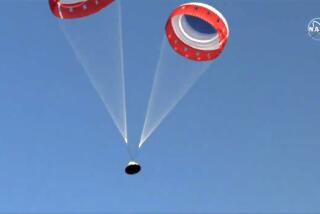Terrified? NASA has reason to be when it comes to Mars landing
- Share via
Sit through NASA’s dramatic “Seven Minutes of Terror” video, about the upcoming landing of the Curiosity rover on Mars, and you might come away certain of one thing: It’s not going to work.
No way. No how.
With the new video, NASA has stirred up interest in its $2.5-billion Mars mission, which aims to determine whether conditions existed at any time to support microbial life on the Red Planet. But “Terror,” with its thrumming soundtrack and movie-preview aura, could inspire serious doubts in viewers about the advisability of the project.
SPACE IMAGES: Mickey on Mercury and more
But look beyond this little infusion of Hollywood at NASA and you’ll find that scientists at California’s Jet Propulsion Laboratory aren’t shaking in their boots. JPL manages the Mars rover projects for NASA.
“Are we terrified? I think we’re confident in what we’ve designed,” scientist Ashwin R. Vasavada said in an interview Wednesday morning with the Los Angeles Times. “But we’re all human. Everything we’ve worked for -- the scientific discoveries, the proven engineering, the contributions we make toward future NASA missions -- it all lies on the other side of those seven minutes.”
There are four main segments to the landing, according to Vasavada, deputy project scientist with the Mars Science Laboratory at JPL. Here, very briefly, is what should happen in the seven minutes it takes for the craft to descend from the atmosphere of Mars and for the rover to land on the surface of the planet:
1) Entry: The heat shield withstands the initial heat (1,600 degrees Fahrenheit) of entering Mars’ atmosphere and slows the spacecraft from its speed of 13,000 miles per hour.
2) Opening of the supersonic parachute: Several miles above the surface of the planet, the parachute pops open while the craft is still traveling at Mach 1.7, almost twice the speed of sound. “Even though we’ve taken off 99% of the speed with the heat shield, we’re still going really fast,” Vasavada said. Then the heat shield pops off.
3) Rover exit: About a mile above the surface, Curiosity pops out of the shell attached to the parachute, with eight rockets firing, further slowing its descent.
4) The “sky crane maneuver”: That’s what scientists are calling the lowering of the rover via tethers and its subsequent touchdown on the surface of Mars. Then, the tethers are cut.
Previous Mars rovers Spirit and Opportunity also used rockets and parachutes. But the finale of the landing was very different. Those two rovers landed using airbags. They bounced around a bit on the surface, the air bags retracted, then off went the rovers. But Curiosity is a hefty vehicle -- car-sized, as opposed to golf cart-sized like its predecessors. So changes had to be made -- nervousness-making changes.
“Hundreds and hundreds of events need to go just right during that seven minutes,” said Vasavada, “Computer glitches, stuck valves, software bugs, and even surprises from Mars itself are just a small part of what could take this from us.”
So what is inspiring the confidence? Tests -- thousands of them.
“We have landed on Mars literally thousands of times in computer simulations, wind tunnel tests, drop tests, computer tests, engine firings, radar tests ... and we’re confident we’ve done all that we can to design the system and teach Curiosity how to land herself.”
The rover will be on autopilot. The last bit of information that scientists will impart to the craft will be four hours before touchdown, providing the best information about where the craft is relative to Gale Crater, Curiosity’s intended landing site.
Two orbiters that NASA has in place around Mars, the Odyssey and Mars Reconnaissance, will be syncing up in order to fly over the crater just as Curiosity lands. They will gather data and send it back to scientists on Earth.
But there’s a 14-minute time lag for all radio signals traveling from Mars to Earth.
So for 14 minutes, the hundreds of scientists -- about 700 of them, according to Vasavada -- will be biting their nails and sweating it out, waiting to learn if something has occurred to kill the mission.
“By the time we’re understanding whether the parachute popped out or not,” Vasavada said, “it’s already been alive or dead by 14 minutes.”
A whole class of problems could prove fatal to the mission, the scientist said. If the parachute rips apart and Curiosity hurtles to the ground, recovery wouldn’t be possible. Or if the rockets don’t ignite ... “or a hundred other things I could list.”
Another class of problems could simply alter the mission -- “if the winds are much different than we expect, that might put us a little farther away from where we intend to land.” But these aren’t the kind to induce terror in a scientist’s heart.
On Aug. 5, Vasavada said, the scientists will be in their control room at JPL. Waiting.
“There will be a lot of emotion, one way or another.”
But, he said confidently, the expectation is that Curiosity will land safe and on target.
And then, he said, scientists will immediately begin preparing the rover for what comes next, “its life on the surface of Mars.” That meeting will begin after landing at 12:30 a.m.
“Actually, if it all goes so well, we may all need a minute.”
ALSO:
Opportunity sends home Mars photo
Human colony on Mars and a reality show to boot
Cape Cod shark scare: More people, more sharks, more run-ins
Join Amy Hubbard on Google+
More to Read
Sign up for Essential California
The most important California stories and recommendations in your inbox every morning.
You may occasionally receive promotional content from the Los Angeles Times.











